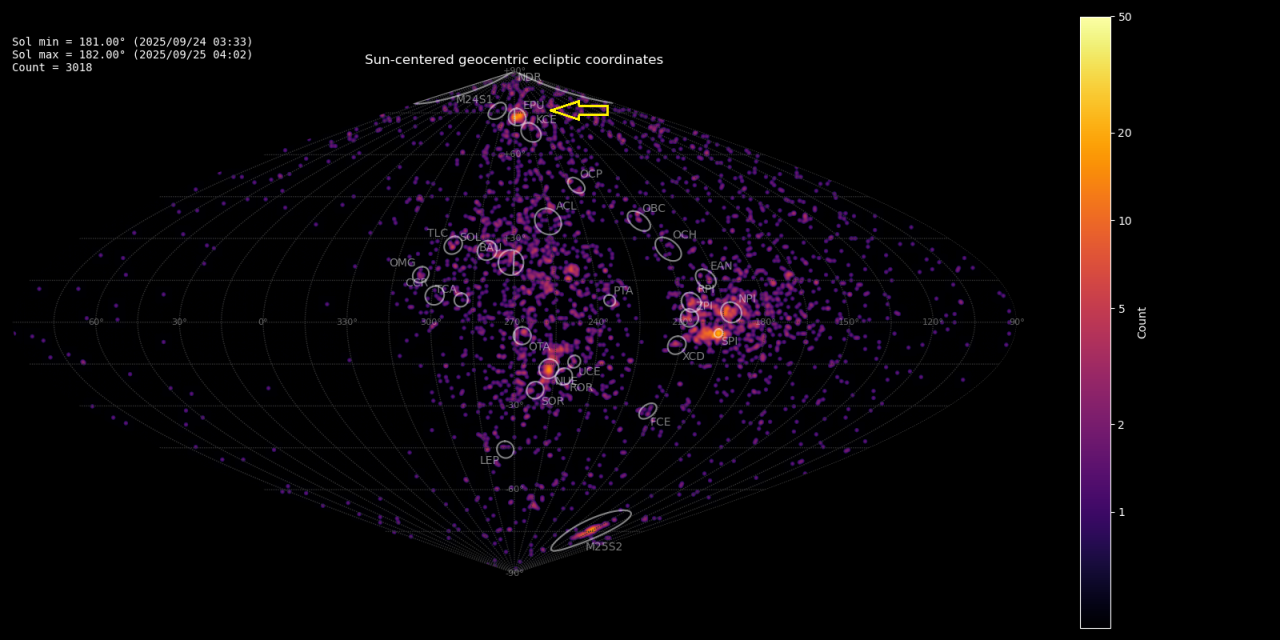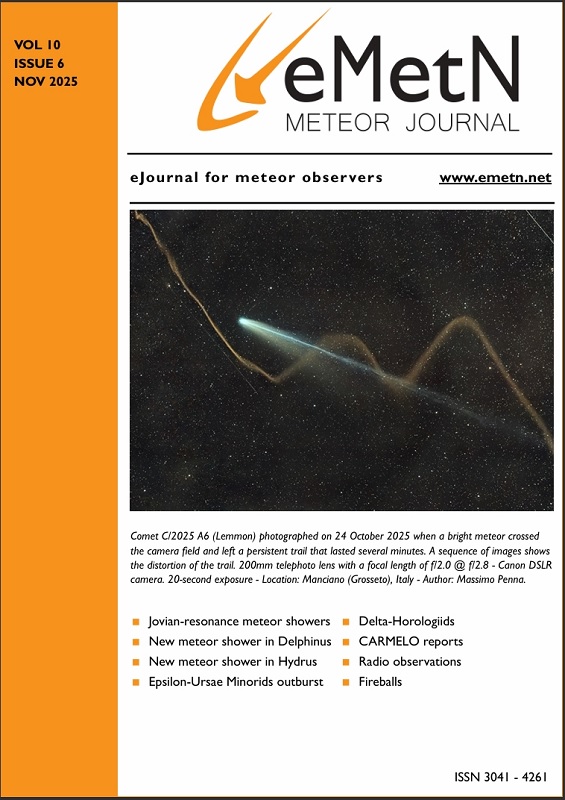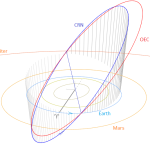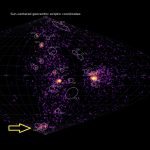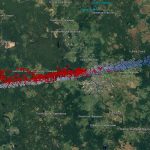By Paul Roggemans, Denis Vida and Damir Šegon
Abstract: Enhanced activity has been detected during 2025 September 23 – 25 from the epsilon-Ursae Minorids (EPU#1044) by the Global Meteor Network. 102 meteors belonging to this meteor shower were observed between 179.6° < λʘ < 182.7° from a radiant at R.A. = 277.7° and Decl.= +82.8°, with a geocentric velocity of 33.8 km/s. The 2025 activity of this meteor shower confirms a 6-year periodicity since its earlier displays in 2019 and 2013.
1 Introduction
While monitoring the newly detected activity source M2025-S2 far south at the southern hemisphere, another hot spot appeared on the GMN radiant density map far north at the northern hemisphere. The radiant source was automatically associated by the GMN tools as the epsilon-Ursae Minorids (EPU#1044), a poorly known minor meteor shower which was first reported in 2020 by Sato et al. (2020) based on thirteen detected shower meteors captured during 2019 September 25–27 UT by the SonotaCo Network. The activity was confirmed by CAMS data as in 2019, September 24–26 UT, seven epsilon Ursae Minorids were detected by the CAMS California network and four by CAMS Florida. The discovery of this shower was based on 19 orbits, 12 from SonotaCo and 7 from CAMS. Another solution in the IAU-MDC for this meteor shower was published by Shiba (2022), based on 10 of the orbits collected by the SonotaCo network in 2019.
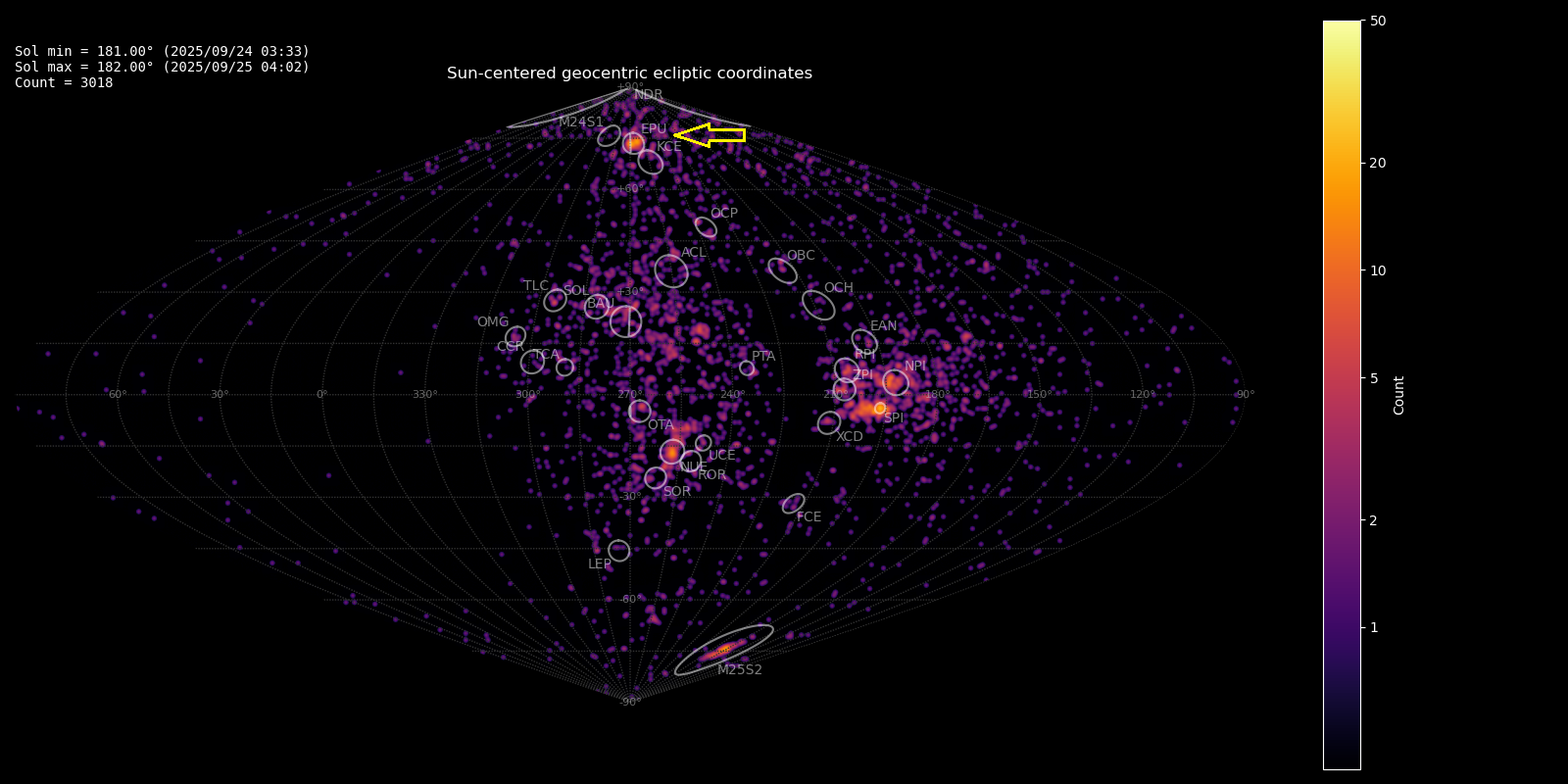
Figure 1 – Heat map with 3018 radiants obtained by the Global Meteor network on September 24 – 25, 2025. A distinct concentration is visible in Sun-centered geocentric ecliptic coordinates at the position known as the radiant of the epsilon-Ursae Minorids (EPU#1044). The activity lasted more than two days.
2 2025 detection of EPU#1044
The GMN shower association criterion assumes that meteors within 1° in solar longitude, within an association radius, in this case of 3° in radiant, and within 10% in geocentric velocity of a shower reference location, are members of that shower. Further details about the shower association are explained in Moorhead et al. (2020). These are rather strict criteria since meteor showers often have a larger dispersion in radiant position, velocity and activity period. Using these meteor shower selection criteria, 134 orbits have been associated with the epsilon-Ursae Minorids in the GMN meteor orbit database in 2025.
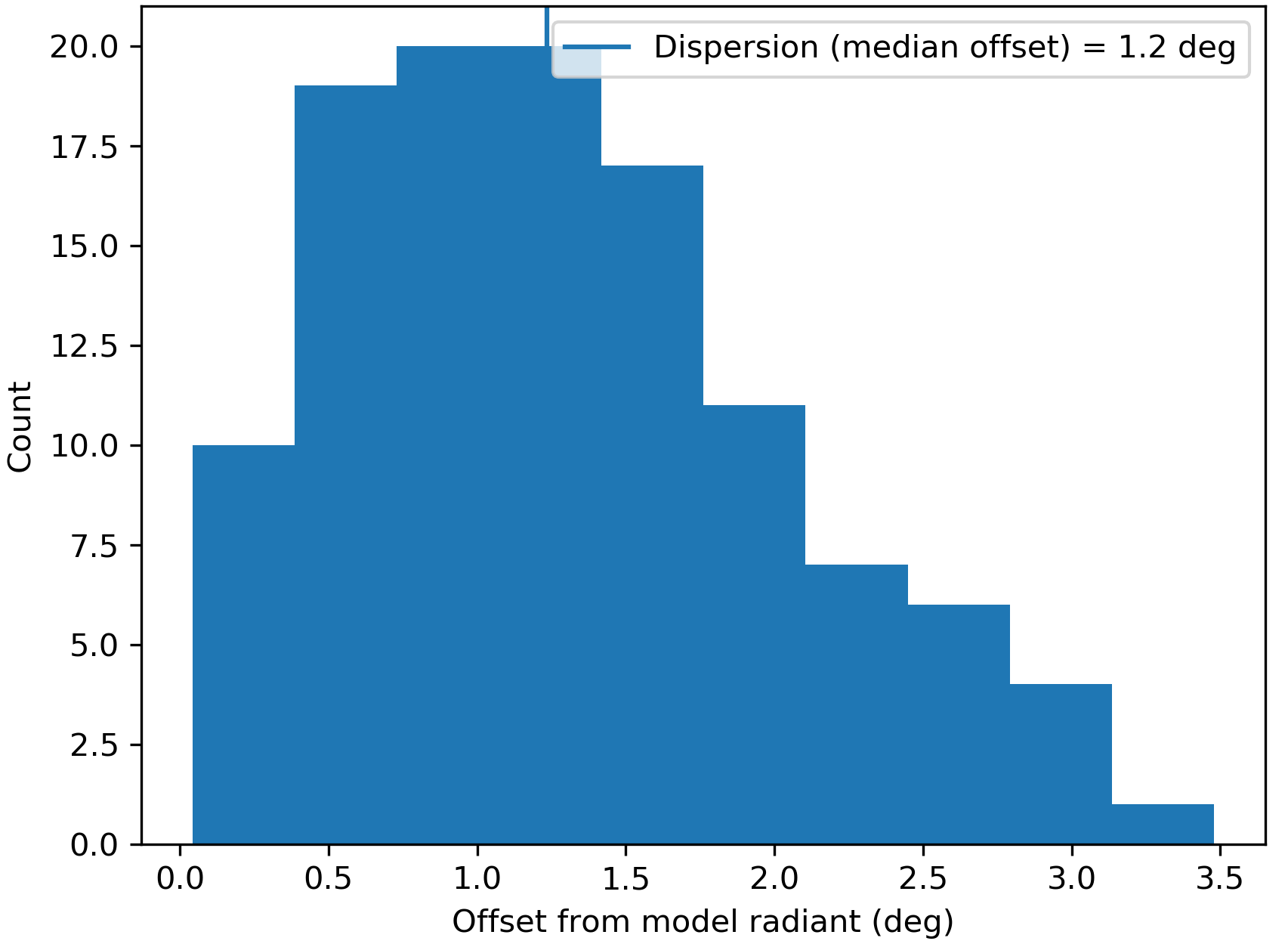
Figure 2 – Dispersion on the radiant position.
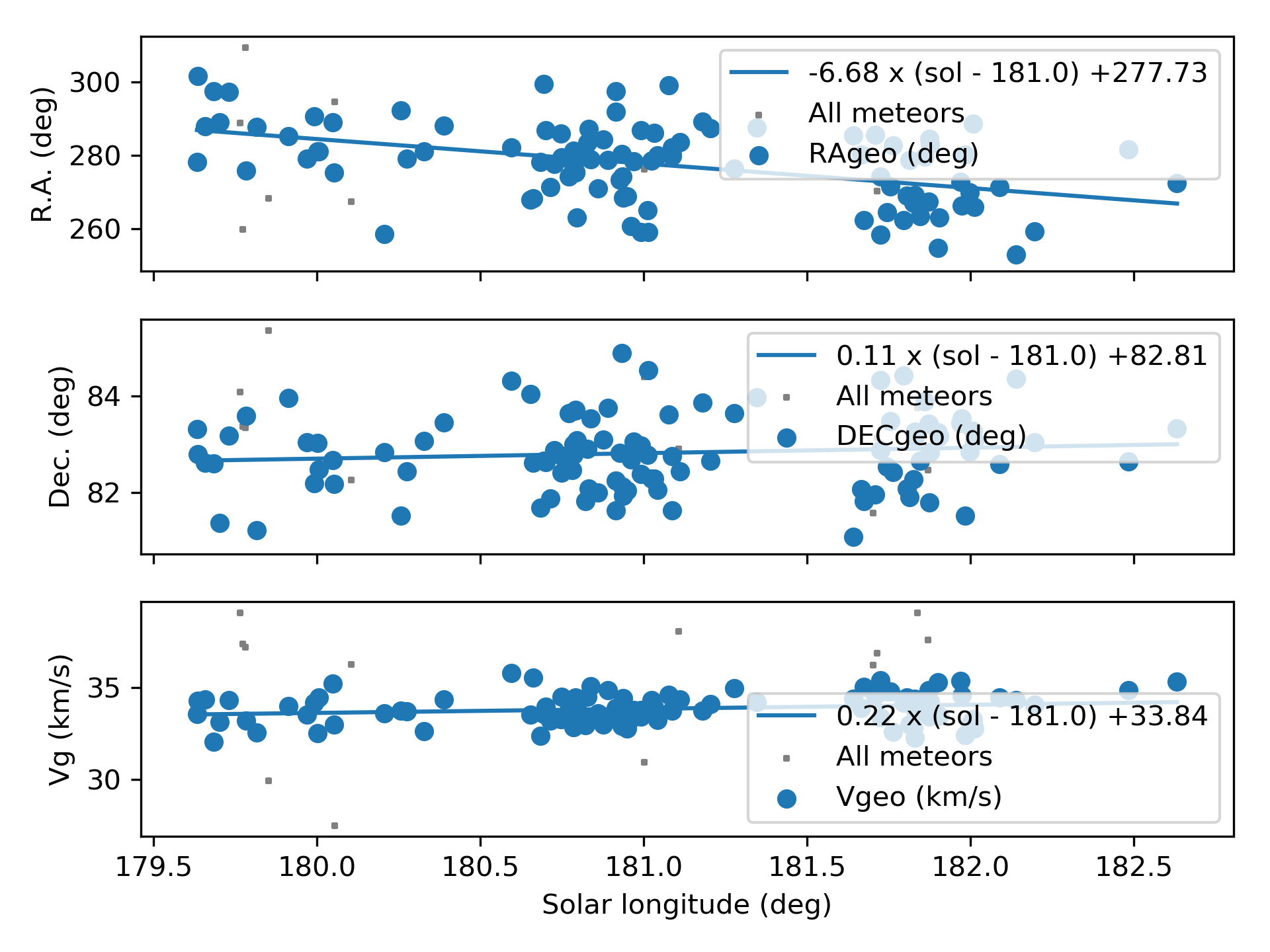
Figure 3 – The radiant drift.
The shower was independently observed by cameras in 19 countries (Belgium, Bosnia and Herzegovina, Bulgaria, Canada, Croatia, Denmark, Germany, Greece, Hungary, Ireland, Portugal, Romania, Russia, Spain, South Korea, Netherlands, Ukraine, United Kingdom and the United States).
The shower had a median geocentric radiant with coordinates R.A. = 277.7°, Decl. = +82.8°, within a circle with a standard deviation of ±1.2° (equinox J2000.0) see Figure 2. The radiant drift in R.A. is –6.7° on the sky per degree of solar longitude and +0.11° in Dec., both referenced to λʘ = 181.0° (Figures 3 and 4). The median Sun-centered ecliptic coordinates were λ – λʘ = 265.5°, β = +73.5° (Figure 5). The geocentric velocity was 33.8 ± 0.1 km/s. The mean orbit has been listed in Table 1.
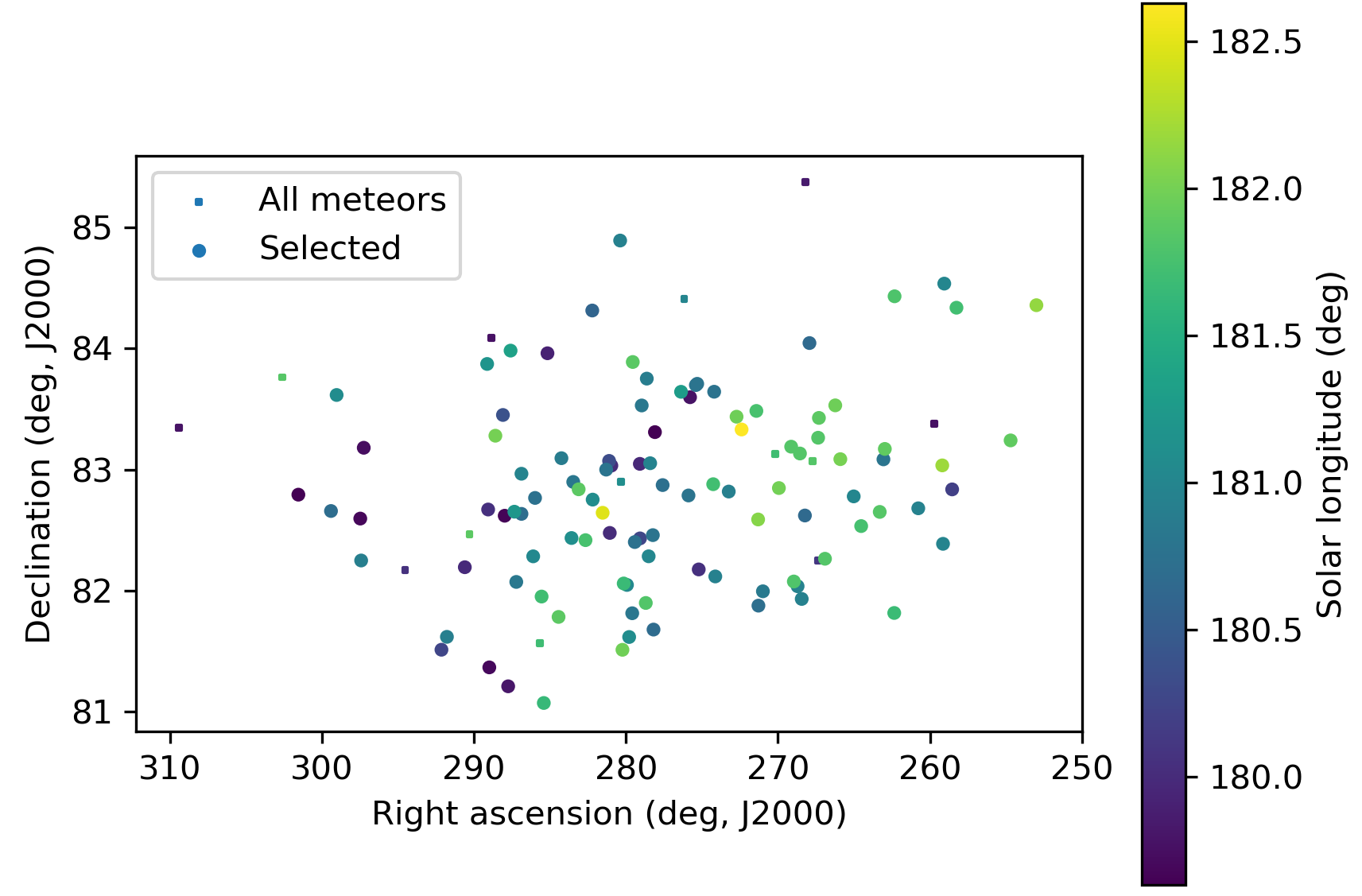
Figure 4 – The radiant distribution during the solar-longitude interval 179.5° – 182.5° in equatorial coordinates.
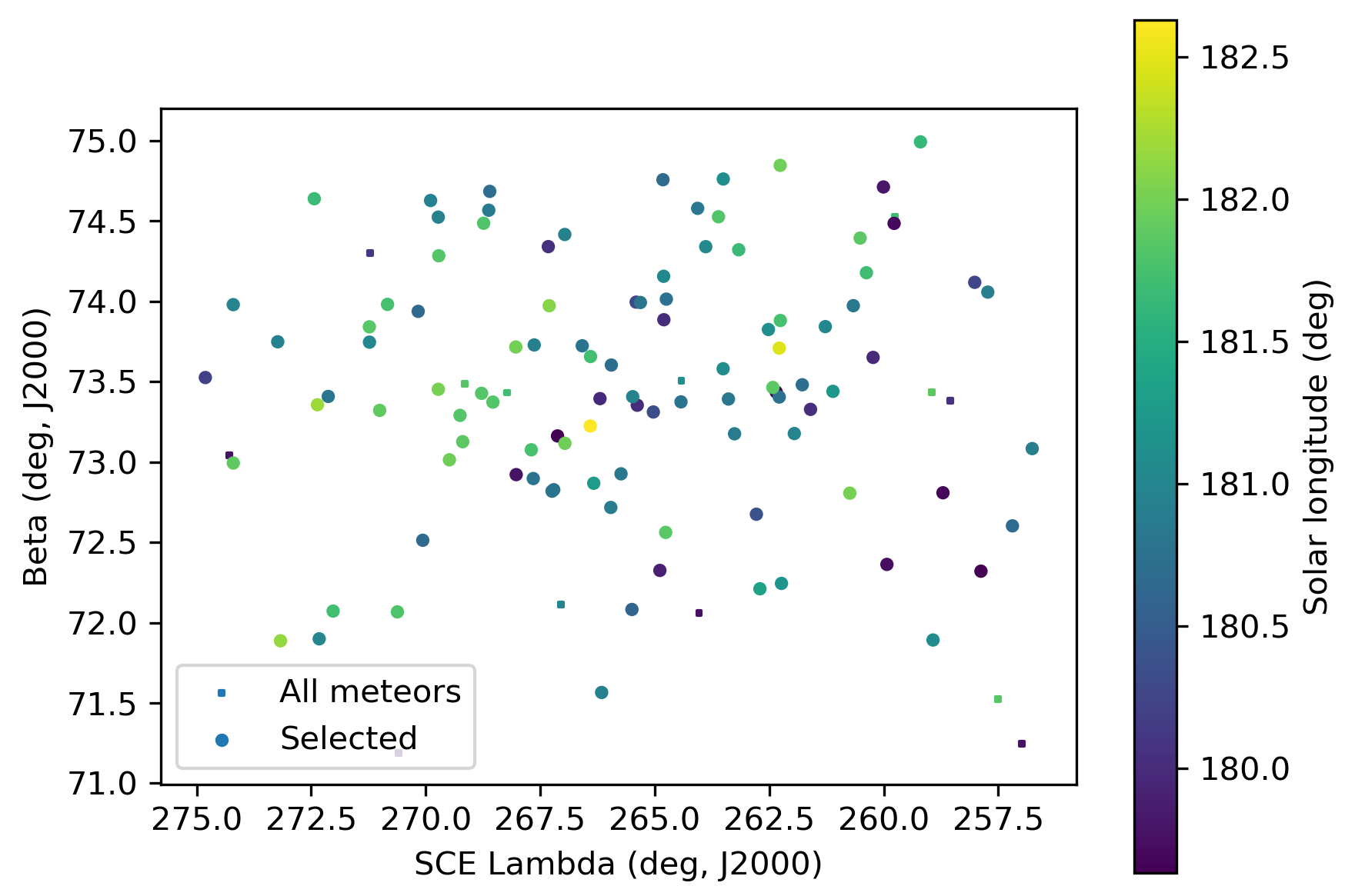
Figure 5 – The radiant distribution during the solar-longitude interval 179.5° – 182.5° in Sun centered geocentric ecliptic coordinates.
3 Another search method
Another method has been applied to check this meteor shower activity in 2025. The starting point here can be any visually spotted concentration of radiant points or any other indication for the occurrence of similar orbits. The method has been described before (Roggemans et al., 2019). The main difference with the method applied in Section 2 is that three different discrimination criteria are combined in order to have only those orbits which fit different criteria. The D-criteria that we use are these of Southworth and Hawkins (1963), Drummond (1981) and Jopek (1993) combined. Instead of using a single cutoff value for the threshold of the D-criteria these values are considered in different classes with different thresholds of similarity. Depending on the dispersion and the type of orbits, the most appropriate threshold of similarity is selected to locate the best fitting mean orbit as the result of an iterative procedure.
This method resulted in a mean orbit with 117 related orbits that fit within the similarity threshold with DSH < 0.125, DD < 0.05 and DJ < 0.125, recorded 2025 September 22 – 26. The radiant plot in geocentric Sun-centered ecliptic coordinates (Figure 6) shows a large dispersion due to the radiant drift with Δ(λ – λʘ) = 1.8°. There is also some dispersion on the longitude of perihelion against inclination (Figure 7).
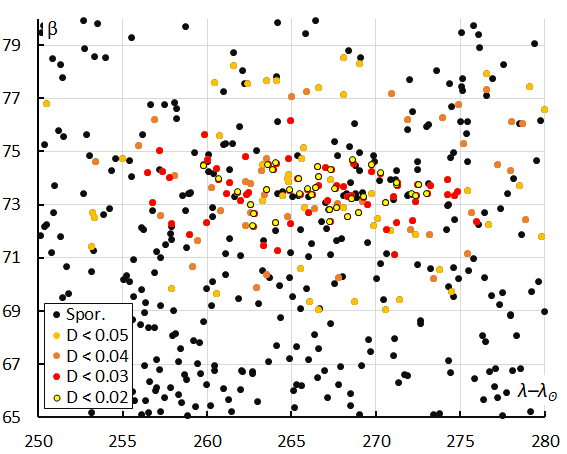
Figure 6 – The radiant distribution during the solar-longitude interval 179° – 183° in Sun-centered geocentric ecliptic coordinates, color coded for four threshold values of the DD orbit similarity criterion.
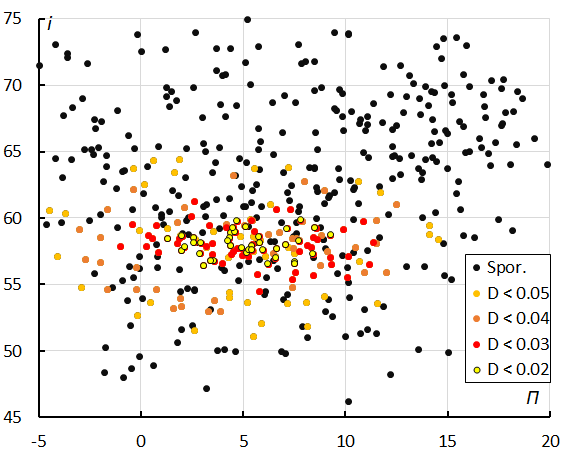
Figure 7 – The diagram of the inclination i against the longitude of perihelion Π color coded for four classes of D criterion threshold.
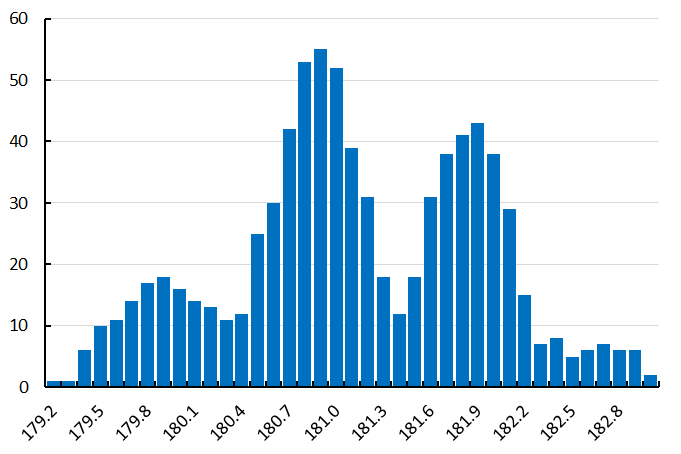
Figure 8 – Number of EPU-orbits recorded by GMN in 2025 counted in time bins of 0.2° in solar longitude.
Most EPU meteors were identified by both methods. The method based on the threshold values of the D-criteria found 18 meteors in 2025 which were not identified as EPU meteors by the GMN method. Twenty-one of the 102 orbits used by the GMN method failed to fit the test within the similarity threshold with DSH < 0.125, DD < 0.05 and DJ < 0.125. Despite that both orbit samples include almost 20% different orbits identified as EPU meteors, the final meteor shower parameters are in very good agreement.
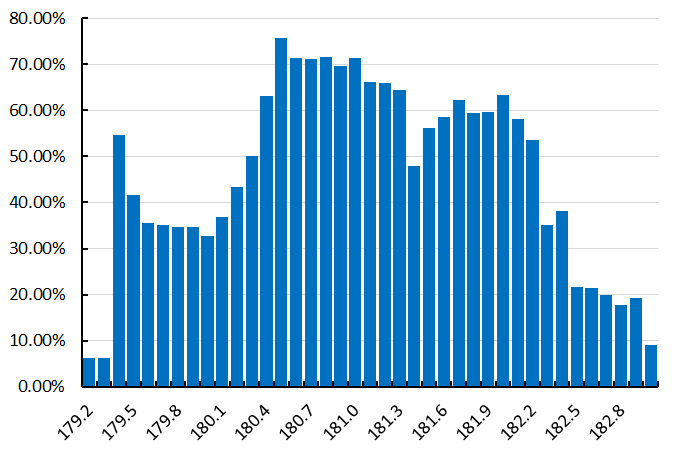
Figure 9 – Percentage of EPU-orbits relative to the total number of orbits recorded by GMN in 2025 at the Northern Hemisphere counted in time bins of 0.2° in solar longitude.
Looking at the raw counts of EPU meteors in bins of 0.2° in solar longitude (Figure 8), we see remarkable dips in the distribution which are due to an observational bias caused by the Pacific gap in the coverage by the network at the Northern Hemisphere. Most GMN stations at these longitudes are situated at the southern hemisphere in Australia and New Zealand where the EPU radiant remained far below the horizon. The total number of GMN cameras is much smaller in the Far East than in Europe where most of the EPU meteors were recorded. Europe had a large number of cameras with clear sky. In this case the number of EPU-meteors recorded says more about the detection capacity of the Global Meteor network than about the shower itself.
The capacity to detect weak activity from minor showers depends on the volume of atmosphere covered for which many camera-stations and clear sky are required. With about 60% of all GMN stations installed in Europe, this part of the network has a huge capacity to sample meteors from very weak sources. This explains why the EPU-activity has been mainly recorded by European cameras. If we look at the ratio EPU-meteors to non-EPU-meteors as a percentage within the sampling area at the sky in Figure 9, the peaks and dips from Figure 8 disappear and it looks like the EPU meteor shower produced a plateau shaped activity profile that lasted almost 2.5 days.
The activity curve with the flux and equivalent ZHR also shows no real peak, but a rather constant level of activity during more than two days (Figure 10). The computed flux of the epsilon-Ursae Minorids in 2025 corresponds to a modest equivalent ZHR of 0.5. Despite such a low value, unexpected enhanced activity from weak activity minor showers is often labelled as an outburst. This can be misleading as a human visual observer will notice nothing of this activity.
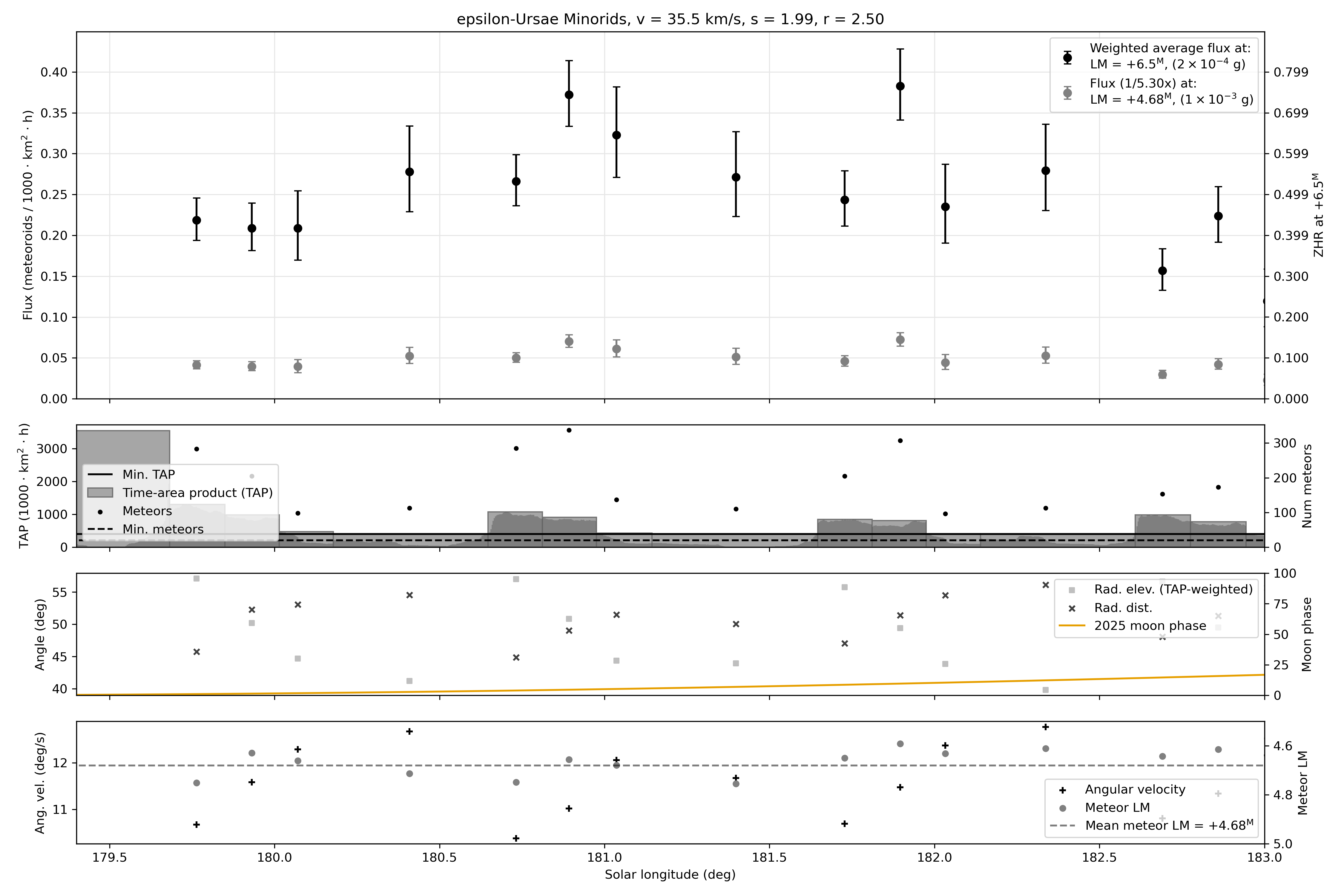
Figure 10 – Plot of the flux for the epsilon-Ursae Minorids in 2025.
4 Comparing past years of EPU activity
Looking up past GMN orbit data, seventeen orbits were found in 2019, thirteen of which during a short time span of 181.2° to 181.8° in solar longitude, confirming the discovery by SonotaCo network. Despite the vast expansion of the camera network of GMN, only three EPU-orbits were recorded in 2020, five in 2021, nine in 2022, sixteen in 2023 and twelve in 2024. The activity level after 2019 remained far below the threshold to attract any attention.
Table 1 – The number of EPU orbits in the GMN orbit dataset with the time of maximum activity.
| Year | EPU orbits | λʘmax |
| 2019 | 17 | 181.4 |
| 2020 | 3 | – |
| 2021 | 5 | – |
| 2022 | 9 | 180.6 |
| 2023 | 16 | 181.0 |
| 2024 | 12 | 180.7 |
| 2025 | 134 | 181.0 |
However, some confusion arose in 2024 when an unknown activity source was discovered by GMN, about 20° in longitude from the EPU-radiant. The GMN analysis concluded that the radiants were too far apart and therefore the detection was reported to the IAU-MDC as a new meteor shower, accepted and registered under the temporary name-designation: M2024-S1 (Vida and Šegon, 2024; Šegon et al., 2025). This new meteor shower had also been detected independently from GMN by Belarus and Ukrainian meteor cameras (Harachka et al., 2024).
Jenniskens et al. (2025) confirmed the activity reported by GMN but suggested that M2024-S1 was more likely another outburst of the epsilon-Ursae-Minorid shower which displayed better than usual activity in 2007, 2013 and 2019. Assuming a periodicity of about 5.7 years, 2024 would fit in this sequence and in that case, we could expect to see this shower again in 2025 with the dust from older ejecta accumulated in a 2:1 mean-motion resonance with Jupiter. That would predict a more regular pattern of outbursts with a 6-year period of resonance. The 2025 enhanced activity recorded by GMN confirms this outburst forecast.
GMN detected weak activity of the EPU-radiant in 2024, only 12 meteors during the shower activity period 179.0° < λʘ < 183.0°. Figure 11 shows the radiant density plots of the northern part of the hemisphere for three nights in 2024 and three nights in 2025. The plots show a clear concentration at the position of the new M2024-S1 radiant, but barely any activity at the EPU-radiant in 2024 (top row). The bottom row in Figure 11 shows the activity in 2025 when both sources were active. In 2025 we see a very distinct activity at the EPU-radiant position which is completely missing in the 2024 plots. M2024-S1 displayed clear activity in 2025, although less pronounced than previous year. The M2024-S1 activity in 2025 has been documented in a separate follow-up report on this shower (Roggemans et al., 2025).
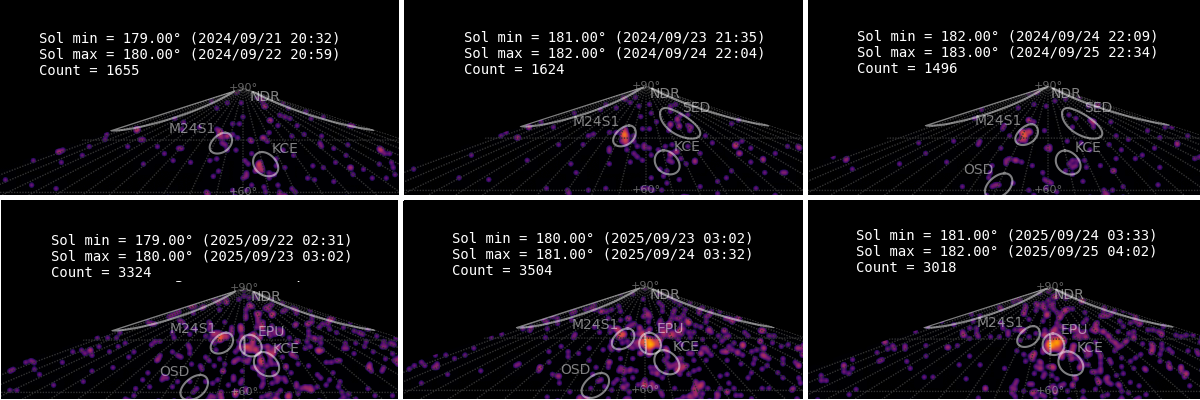
Figure 11 – Comparing the radiant density plots for M2024-S1 and EPU#1044 in 2024 (top) and 2025 (bottom).
5 The EPU orbit and parent body
The Tisserand value relative to Jupiter indicates a Jupiter Family Comet type orbit. A top view is shown in Figure 12. With an inclination of 58° for the EPU orbit and 54° for the M2024-S1 orbit the aphelia remain far above the orbit of Jupiter.
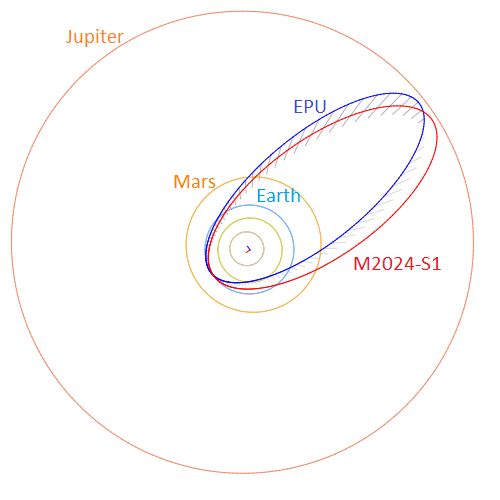
Figure 12 – Comparing the mean orbits for the epsilon-Ursae-Minorids (blue) for M2024-S1 (red), both projected in the ecliptic plane. (Plotted with the Orbit visualization app provided by Pető Zsolt).
Table 2 – Comparing the results for EPU#1044, derived by two different methods, the orbital parameters as derived by the GMN method for 2019 and 2025, the parameters for DD < 0.05 in 2025 and DD < 0.05 for 2019–2025, derived from the method described in Section 3.
| GMN method 2019 | GMN method 2025 |
DD < 0.05 2025 |
DD < 0.05 2019–2025 |
|
| λʘ (°) | 181.4 | 181.0 | 181.0 | 181.0 |
| λʘb (°) | 179.0 | 179.5 | 179.2 | 179.0 |
| λʘe (°) | 183.0 | 183.0 | 183.0 | 183.0 |
| αg (°) | 269.1 | 277.7 | 276.9 | 275.7 |
| δg (°) | +82.3 | +82.8 | +82.7 | +82.8 |
| Δαg (°) | –6.04 | –6.68 | –5.0 | –4.2 |
| Δδg (°) | +0.13 | +0.11 | –0.38 | –0.2 |
| vg (km/s) | 34.0 | 33.8 | 33.7 | 33.8 |
| λg (°) | 89.8 | 86.5 | 86.6 | 87.5 |
| λg – λʘ (°) | 268.4 | 265.5 | 265.9 | 266.5 |
| βg (°) | +74.0 | +73.5 | +73.7 | +73.5 |
| Hb (km) | 91.4 | 90.6 | 91.2 | 92.5 |
| He (km) | 81.7 | 79.9 | 80.4 | 81.3 |
| Hp (km) | 85.8 | 82.7 | 83.4 | 85.4 |
| MagA | –0.19 | –0.72 | –0.64 | –0.39 |
| a (A.U.) | 3.18 | 2.88 | 2.84 | 2.82 |
| q (A.U.) | 1.0018 | 1.0012 | 1.0006 | 1.0019 |
| e | 0.685 | 0.652 | 0.648 | 0.644 |
| i (°) | 58.2 | 58.2 | 57.6 | 58.0 |
| ω (°) | 182.4 | 184.6 | 184.3 | 183.9 |
| Ω (°) | 181.6 | 181.1 | 181.1 | 181.2 |
| Π (°) | 4.0 | 5.7 | 5.5 | 5.1 |
| Tj | 2.24 | 2.40 | 2.44 | 2.44 |
| N | 17 | 102 | 117 | 176 |
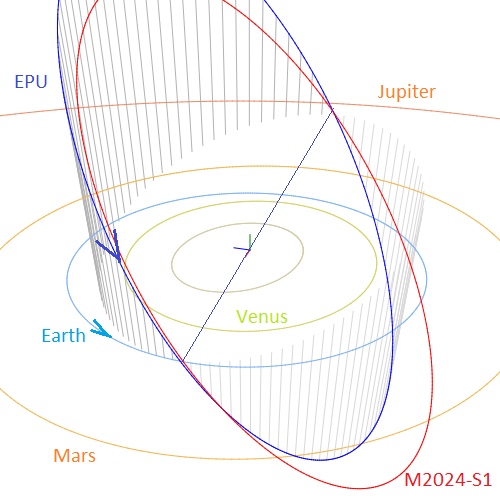
Figure 13 – Comparing the mean orbits for the epsilon-Ursae-Minorids (blue) for M2024-S1 (red), close-up at the inner Solar System. (Plotted with the Orbit visualization app provided by Pető Zsolt.
Looking in close up at the nodes we see that both showers encounter the Earth almost simultaneously at their descending nodes (Figure 13). The positions of the ascending nodes are relatively close to the orbit of Jupiter and the dust will be strongly affected by gravitational perturbation when the planet passes near this point. The six-year periodicity as well as the likely dynamic connection between both showers may be caused by these gravitational effects.
A remarkable characteristic of the EPU-meteors is that these penetrate deep into the atmosphere with a median beginning height at 90.6 ± 5.0 km and ending height at 79.9 ± 4.9 km. Most EPU meteors had negative magnitudes with a median peak absolute magnitude of –0.7. This low ablation height was noticed before by Shiba (2022) who mentioned “Luminous height is especially low”. This means these meteoroids aren’t fragile like expected for cometary material but rather solid particles comparable to the Geminids (GEM#4) where the perihelion distance of q = 0.14 AU close to the Sun is the explanation for the dense composition of the particles. The EPU-orbits gets nowhere much closer to the Sun than the comfort zone at about 1 AU and thus solar radiation cannot explain the solid nature of these meteoroids.
For completeness we mention the mean orbits obtained by GMN for 2019, 2023 and 2024 obtained with the D-criteria method. The number of meteors is small and thus the parameters are less certain due to small-number statistics. Note that the radiant position both in R.A. as in Sun-centered ecliptic longitude for all the years of GMN data is about 10 degrees east from the radiant positions published for 2019 in the IAU-MDC working list of meteor showers. The radiant density map in Sun-centered ecliptic coordinates for GMN on 2019, September 24–25
(Figure 14) clearly confirms the position of the radiant listed in Tables 2 and 3.
Table 3 – The results for EPU#1044, using D-criteria thresholds for DSH < 0.125, DD < 0.05 and DJ < 0.125, derived from the method described in Section 3.
| GMN 2019 | GMN 2023 | GMN2024 | |
| λʘ (°) | 181.4 | 181.0 | 180.7 |
| λʘb (°) | 180.3 | 179.2 | 179.0 |
| λʘe (°) | 181.8 | 182.4 | 182.2 |
| αg (°) | 267.5 | 276.0 | 261.2 |
| δg (°) | +82.7 | +80.8 | +84.1 |
| Hb (km) | 91.1 | 99.6 | 91.8 |
| He (km) | 81.4 | 86.7 | 82.4 |
| Hp (km) | 85.7 | 91.3 | 86.5 |
| MagA | –0.33 | +0.16 | –0.40 |
| vg (km/s) | 34.0 | 33.1 | 34.4 |
| λg (°) | 91.1 | 87.3 | 92.6 |
| λg – λʘ (°) | 269.6 | 265.8 | 271.3 |
| βg (°) | +73.5 | +75.0 | +72.3 |
| a (A.U.) | 2.93 | 2.84 | 2.80 |
| q (A.U.) | 1.002 | 0.998 | 1.001 |
| e | 0.658 | 0.648 | 0.642 |
| i (°) | 58.1 | 56.6 | 60.0 |
| ω (°) | 182.8 | 184.1 | 181.0 |
| Ω (°) | 181.4 | 180.8 | 180.7 |
| Π (°) | 4.2 | 5.0 | 1.8 |
| Tj | 2.37 | 2.45 | 2.42 |
| N | 14 | 16 | 12 |
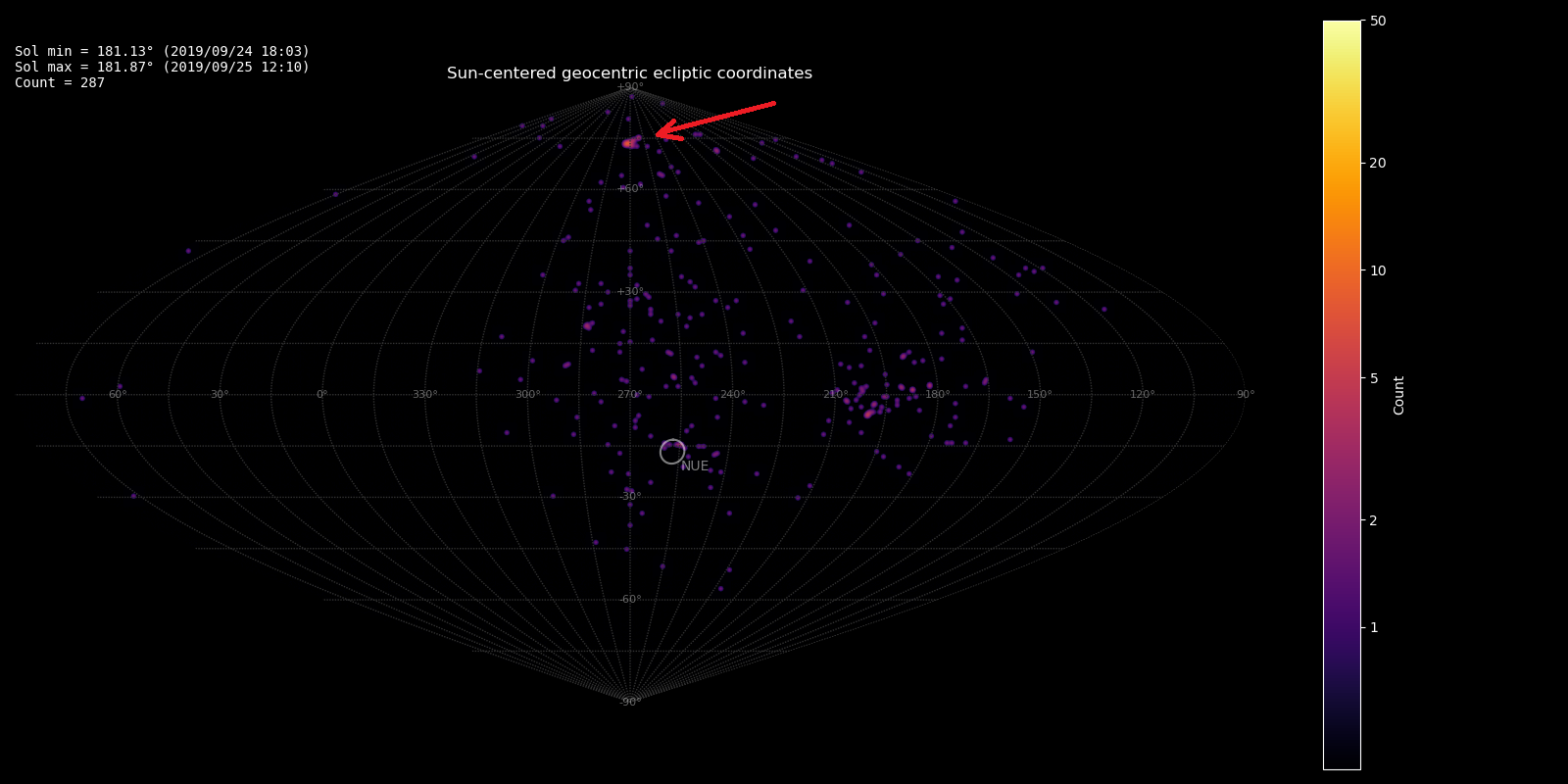
Figure 14 – Heat map with 287 radiants obtained by the Global Meteor network on September 24 – 25, 2019. A distinct concentration is visible in Sun-centered geocentric ecliptic coordinates at the position known as the radiant of the epsilon-Ursae Minorids (EPU#1044).
Table 4 – Top ten matches of a search for possible parent bodies with DD < 0.17.
| Name | DD |
| 2009 SG18 | 0.072 |
| 2021 HK12 | 0.088 |
| 2024 RK16 | 0.127 |
| 2020 UP3 | 0.134 |
| (163732) 2003 KP2 | 0.149 |
| 2010 QA5 | 0.154 |
| 2021 VB4 | 0.156 |
| 2019 QF6 | 0.163 |
| 21P/Giacobini-Zinner | 0.165 |
| 2014 XX7 | 0.167 |
Table 4 list ten possible parent bodies with two most likely parent bodies, 2009 SG18 and 2021 HK12. The modeling for 2009SG18 has been done in the past for a possible association with the kappa-Cepheids (KCE#751) (Šegon et al., 2017). However, the model produced no intersections with the Earth orbit for 2025 thus this is not the parent body.
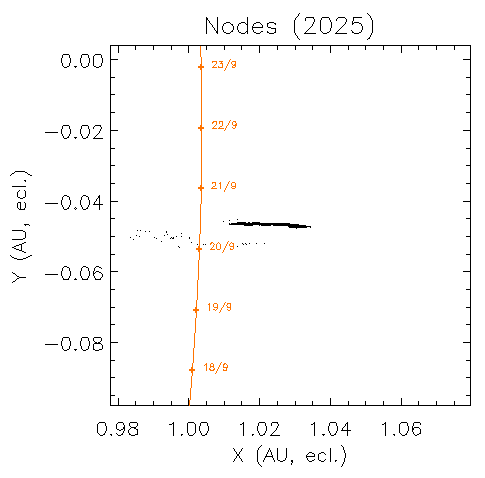
Figure 14 – Location of the nodes of the particles in 2025 released by 2009 SG18 over several centuries. (Model by J. Vaubaillon).
The next candidate, 2021 HK12, has as orbital parameters:
- q = 1.036 AU,
- e = 0.685,
- i = 47.0°,
- ω = 168.8°,
- Ω = 187.1°,
- Tj = 2.37.
This object with a Jupiter Family Comet type orbit could be related to both the epsilon-Ursae-Minorids and the new source M2024-S1.
6 Conclusion
Significant enhanced activity of the epsilon-Ursae-Minorids has been observed in 2025 by the Global Meteor Network during 23–25 September. This activity confirms the prediction of a possible outburst in 2025, based on a
6-year periodicity by Jenniskens et al. (2025). A peculiar characteristic of this shower is the remarkable low ablation height of the meteors which indicate that the meteoroids consist of solid material. The simultaneous reoccurrence of the new shower discovered by GMN in 2024 and registered as M2024-S1 in the IAU-MDC Working List of Meteor Showers confirms that both activity sources should be regarded as separate meteor showers because of the differences in radiant position and orbital parameters. Both meteor showers are very likely dynamically related to each other. The asteroid 2021 HK12 remains a plausible candidate as parent body.
Acknowledgment
This report is based on the data of the Global Meteor Network (Vida et al., 2020a; 2020b; 2021) which is released under the CC BY 4.0 license. We thank all 825 participants in the Global Meteor Network project for their contribution and perseverance. A list with the names of the volunteers who contribute to GMN has been published in the 2024 annual report (Roggemans et al., 2025).
References
Drummond J. D. (1981). “A test of comet and meteor shower associations”. Icarus, 45, 545–553.
Harachka Y., Mikulich A., Morozov K., Angelsky A. (2024). “Possible new meteor shower in Ursa Minor”. eMetN Meteor Journal, 9, 395–396.
Jenniskens P., Johannink C., Moskovitz N., Howell A. (2025). “Short note on what appears to have been a 2024 outburst of epsilon-Ursae-Minorids (IAU#1044)”. eMetN Meteor Journal, 10, 20–21.
Jopek T. J. (1993). “Remarks on the meteor orbital similarity D-criterion”. Icarus, 106, 603–607.
Jopek T. J., Rudawska R. and Pretka-Ziomek H. (2006). “Calculation of the mean orbit of a meteoroid stream”. Monthly Notices of the Royal Astronomical Society, 371, 1367–1372.
Moorhead A. V., Clements T. D., Vida D. (2020). “Realistic gravitational focusing of meteoroid streams”. Monthly Notices of the Royal Astronomical Society, 494, 2982–2994.
Roggemans P., Johannink C. and Campbell-Burns P. (2019a). “October Ursae Majorids (OCU#333)”. eMetN Meteor Journal, 4, 55–64.
Roggemans P., Campbell-Burns P., Kalina M., McIntyre M., Scott J. M., Šegon D., Vida D. (2025). “Global Meteor Network report 2024”. eMetN Meteor Journal, 10, 67–101.
Roggemans P., Vida D., Šegon D. (2025). “M2024-S1 activity confirmed in 2025”. eMetN Meteor Journal, 10, to be published.
Sato H., Jenniskens P., Howell A. (2020). “Epsilon Ursae Minorid Meteor Shower 2019”. CBET 4860.
Šegon D., Vaubaillon J., Gural P.S., Vida D., Željko A., Korlevic K. and Skokic I. (2017). “Dynamical modeling validation of parent bodies associated with newly discovered CMN meteor showers”. Astronomy & Astrophysics, 598, A15. 13 pages.
Šegon D., Vida D., Roggemans P. (2025). “New meteor shower in Ursa Minor 23–24 September 2024”. eMetN Meteor Journal, 10, 12–19.
Shiba Y. (2022). “Jupiter Family Meteor Showers by SonotaCo Network Observations”. WGN, Journal of the International Meteor Organization, 50, 38–61.
Southworth R. B. and Hawkins G. S. (1963). “Statistics of meteor streams”. Smithsonian Contributions to Astrophysics, 7, 261–285.
Vida D., Gural P., Brown P., Campbell-Brown M., Wiegert P. (2020a). “Estimating trajectories of meteors: an observational Monte Carlo approach – I. Theory”. Monthly Notices of the Royal Astronomical Society, 491, 2688–2705.
Vida D., Gural P., Brown P., Campbell-Brown M., Wiegert P. (2020b). “Estimating trajectories of meteors: an observational Monte Carlo approach – II. Results”. Monthly Notices of the Royal Astronomical Society, 491, 3996–4011.
Vida D., Šegon D., Gural P. S., Brown P. G., McIntyre M. J. M., Dijkema T. J., Pavletić L., Kukić P., Mazur M. J., Eschman P., Roggemans P., Merlak A., Zubrović D. (2021). “The Global Meteor Network – Methodology and first results”. Monthly Notices of the Royal Astronomical Society, 506, 5046–5074.
Vida D., Šegon D. (2024). New meteor shower M2024-S1 in Ursa minor. CBET 5452. D. W. E. Green (ed.), 1 pp.

